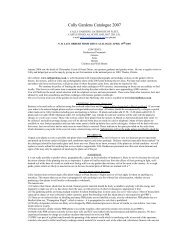Download the catalogue (pdf) - Cally Gardens
Download the catalogue (pdf) - Cally Gardens
Download the catalogue (pdf) - Cally Gardens
Create successful ePaper yourself
Turn your PDF publications into a flip-book with our unique Google optimized e-Paper software.
* ‘Tresco Pink’ Soft pink selections from <strong>the</strong> Tresco Hybrids, 2’-3’ .......................................................3.80<br />
* ‘Tresco Mauve’ Mauve selections from <strong>the</strong> Tresco Hybrids, 2’-3’ .......................................................3.80<br />
* ‘Tresco Orange’ Pale apricot orange selections from <strong>the</strong> Tresco Hybrids, 2’-3’...................................3.80<br />
YUCCA, Agavaceae.<br />
flaccida ‘Ivory’ Free flowering old variety of this exotic-looking evergreen desert plant, surprisingly hardy<br />
given good drainage and full sun, impressive spikes of white bells in late summer, 4’ .........................3.50<br />
GRASSES, SEDGES AND BAMBOOS<br />
The clumps of narrow leaves are a good contrast to broad foliage and <strong>the</strong> usually light, fea<strong>the</strong>ry flower heads<br />
provide a foil for bright colours; many species give yellow or pale brown autumn and look good covered with<br />
frost in <strong>the</strong> winter. Generally easy to grow.<br />
BRIZA, Poaceae.<br />
media ‘Limouzi’ Quaking Grass, masses of dainty mauve flower heads that dance in <strong>the</strong> wind, 2’ .....2.80<br />
CALAMAGROSTIS, Poaceae.<br />
acutiflora ‘Overdam’ Conspicuous cream variegated form of this strongly vertical grass, fea<strong>the</strong>ry brown<br />
flower heads fading to grey, 5’, divisions ............................................................................................... 3.50<br />
emodensis Our Poaceae ex Yunnan, sp. 233 and sp. 28 all appear to be forms of this attractive grass, large<br />
arching flower heads pale reddish brown in autumn and persisting into <strong>the</strong> winter, 4’6”, 1.5 litres .....4.80<br />
CAREX, Cyperaceae.<br />
The Sedges provide lush shiny greenery and interesting flowers in damp soil.<br />
comans ‘Bronze Form’ Mophead of pale brown hair-like leaves with a pinkish tone, 12” .................. 2.50<br />
muskingumensis Palm Sedge, upright stems bearing narrow bright green leaves that droop at <strong>the</strong> ends,<br />
unique effect, broad 18” mound, large divisions ....................................................................................4.20<br />
muskingumensis ‘Little Midge’ New dwarf Palm Sedge making a dense 12” mound of narrow horizontal<br />
leaves that droop at <strong>the</strong> ends, unique effect, 1.5 litres............................................................................4.80<br />
DESCHAMPSIA, Poaceae.<br />
flexuosa ‘Willow Green’ This scarce compact variety always attracts attention, bright yellow hair-like<br />
leaves with contrasting purple flower spikes opening to silvery panicles, 18”, litres ............................4.50<br />
FARGESIA, Poaceae.<br />
murieliae ‘Simba’ Perhaps <strong>the</strong> best bamboo for smaller gardens, slowly makes a graceful 6’ x 6’ light<br />
green clump ............................................................................................................................................ 4.50<br />
HAKONECHLOA, Poaceae.<br />
macra ‘Aureola’ Slowly forms a broad mound of soft yellow leaves with a few slender green lines,<br />
pinkish sprays in autumn, lovely variety ................................................................................................3.20<br />
m. ‘Albovariegata’ Leaves edged and centrally veined cream, 15” ......................................................3.20<br />
INDOCALAMUS, Poaceae.<br />
tessellatus The 4’ stems arch under <strong>the</strong> weight of <strong>the</strong> largest leaves of any hardy bamboo, up to 18” long,<br />
spreads slowly, 1.5 ................................................................................................................................. 5.80<br />
LUZULA, Juncaceae.<br />
Woodrush, good evergreen ground cover in sun or shade.<br />
nivea Snowy Woodrush, conspicuous white flower heads, downy grey leaves, 2’ ................................3.20<br />
sylvatica ‘Tauernpass’ Low growing with handsome broad leaves making excellent ground cover even in<br />
dry shade, 12” ......................................................................................................................................... 2.30<br />
MISCANTHUS, Poaceae.<br />
Many of <strong>the</strong> best larger ornamental grasses are to be found here, <strong>the</strong> clumps increase slowly and are<br />
particularly effective in winter as <strong>the</strong> stout stems and bleached pale brown foliage persist until spring.<br />
giganteus The largest fully hardy grass, each year this makes a bamboo-like 10’ fountain of arching leaves<br />
which pass through many shades of orange and brown in autumn, <strong>the</strong> bleached stems are effective all<br />
winter, divisions ..................................................................................................................................... 4.50<br />
23



